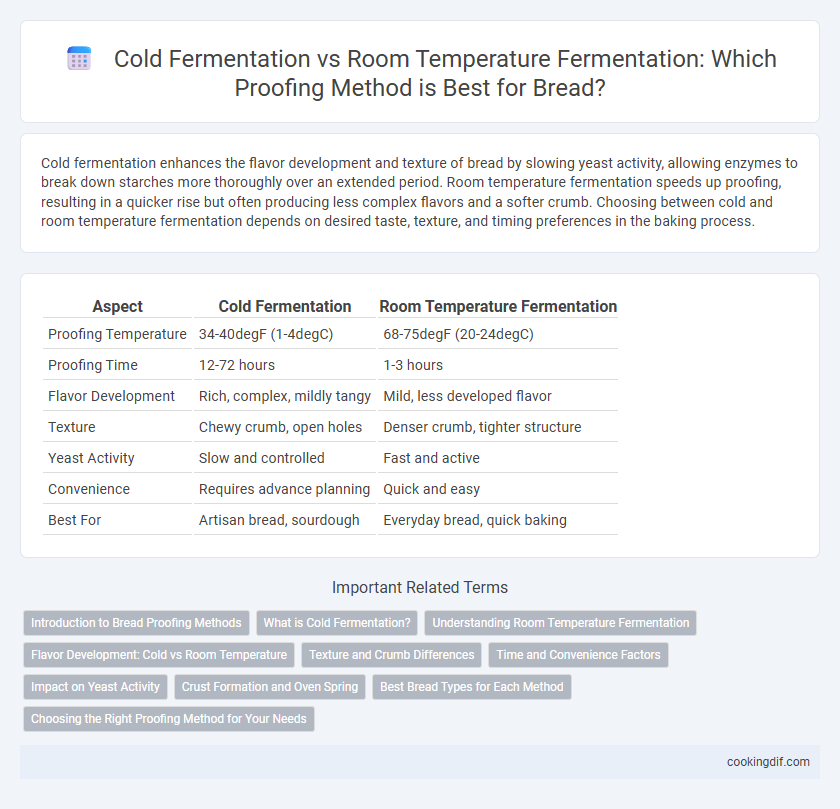Cold fermentation enhances the flavor development and texture of bread by slowing yeast activity, allowing enzymes to break down starches more thoroughly over an extended period. Room temperature fermentation speeds up proofing, resulting in a quicker rise but often producing less complex flavors and a softer crumb. Choosing between cold and room temperature fermentation depends on desired taste, texture, and timing preferences in the baking process.
Table of Comparison
| Aspect | Cold Fermentation | Room Temperature Fermentation |
|---|---|---|
| Proofing Temperature | 34-40degF (1-4degC) | 68-75degF (20-24degC) |
| Proofing Time | 12-72 hours | 1-3 hours |
| Flavor Development | Rich, complex, mildly tangy | Mild, less developed flavor |
| Texture | Chewy crumb, open holes | Denser crumb, tighter structure |
| Yeast Activity | Slow and controlled | Fast and active |
| Convenience | Requires advance planning | Quick and easy |
| Best For | Artisan bread, sourdough | Everyday bread, quick baking |
Introduction to Bread Proofing Methods
Cold fermentation extends the proofing process by allowing dough to rest at temperatures between 35degF and 45degF (1.6degC to 7.2degC), enhancing flavor development and gluten strength over 12 to 72 hours. Room temperature fermentation occurs at approximately 70degF to 75degF (21degC to 24degC), resulting in faster yeast activity and shorter proofing times, typically 1 to 3 hours. Both methods influence crumb texture, crust formation, and overall bread quality, with cold fermentation favoring complex flavor profiles and room temperature fermentation providing efficiency.
What is Cold Fermentation?
Cold fermentation is a bread proofing technique where dough is allowed to ferment slowly in a refrigerator, typically between 35degF and 45degF (1.5degC to 7degC), for an extended period ranging from 12 to 72 hours. This slow fermentation enhances the development of complex flavors and improves the dough's texture by allowing yeast and enzymes to work gradually. Cold fermentation also results in a better crust and crumb structure due to the prolonged enzymatic activity and controlled yeast growth.
Understanding Room Temperature Fermentation
Room temperature fermentation typically occurs between 70degF and 75degF, promoting faster yeast activity and quicker proofing times compared to cold fermentation. This method develops moderate flavor complexity and a soft crumb texture, ideal for everyday bread baking where time efficiency is crucial. Maintaining consistent ambient temperatures during room temperature fermentation ensures optimal dough rise and texture, preventing over-proofing or under-proofing.
Flavor Development: Cold vs Room Temperature
Cold fermentation enhances flavor complexity by allowing slower yeast activity, resulting in increased organic acid and ester production that deepens the bread's aromatic profile. Room temperature fermentation accelerates proofing but often limits flavor development, producing a milder taste with fewer nuanced aromatic compounds. The extended cold fermentation method is preferred for artisanal breads seeking rich, tangy, and well-rounded flavors.
Texture and Crumb Differences
Cold fermentation enhances flavor complexity and produces a chewier texture with a more open crumb due to slower yeast activity and prolonged enzymatic reactions. Room temperature fermentation accelerates proofing, resulting in a softer crust and finer, denser crumb structure with less developed taste profiles. Choosing cold fermentation often yields bread with superior texture and a more artisan appearance, while room temperature proofing suits quicker baking needs.
Time and Convenience Factors
Cold fermentation for bread proofing extends over 12 to 72 hours, enhancing flavor complexity and texture while requiring minimal active time, ideal for bakers seeking convenience and planned preparation. Room temperature fermentation completes within 1 to 4 hours, offering a faster rise but demanding attentive timing and warmer conditions that can vary with ambient temperature. Choosing between cold and room temperature fermentation balances time investment against flavor development and scheduling flexibility in the bread-making process.
Impact on Yeast Activity
Cold fermentation slows yeast activity by maintaining dough temperatures between 38degF and 55degF, allowing for a prolonged proofing period that enhances flavor complexity and texture development. Room temperature fermentation, typically conducted at 70degF to 75degF, accelerates yeast metabolism, resulting in faster rise times but less nuanced flavor profiles. Managing fermentation temperature directly influences the production of organic acids and alcohols, critical compounds produced by yeast that affect dough elasticity and bread crumb structure.
Crust Formation and Oven Spring
Cold fermentation slows yeast activity, allowing enzymes to develop complex flavors and improve dough strength, leading to a thicker, crunchier crust during baking. Room temperature fermentation accelerates yeast fermentation, resulting in faster gas production and a lighter, airier oven spring but often a thinner crust. Optimal bread texture requires balancing fermentation times to enhance oven spring while achieving the desired crust formation.
Best Bread Types for Each Method
Slow cold fermentation enhances flavor complexity and crust texture, making it ideal for sourdough, ciabatta, and baguettes that benefit from extended fermentation. Room temperature fermentation accelerates yeast activity, perfect for soft, tender breads like sandwich loaves, brioche, and dinner rolls requiring quicker proofing. Choosing the right fermentation method depends on bread type, desired texture, and flavor development goals.
Choosing the Right Proofing Method for Your Needs
Cold fermentation enhances flavor complexity and dough texture by allowing slow yeast activity at temperatures between 35degF and 45degF over 12 to 72 hours. Room temperature fermentation, typically at 70degF to 75degF for 1 to 3 hours, accelerates proofing but may produce less nuanced flavors. Select cold fermentation for artisan breads requiring depth and chewiness, while room temperature proofing suits quick, everyday baking needs.
Cold Fermentation vs Room Temperature Fermentation for proofing Infographic

 cookingdif.com
cookingdif.com